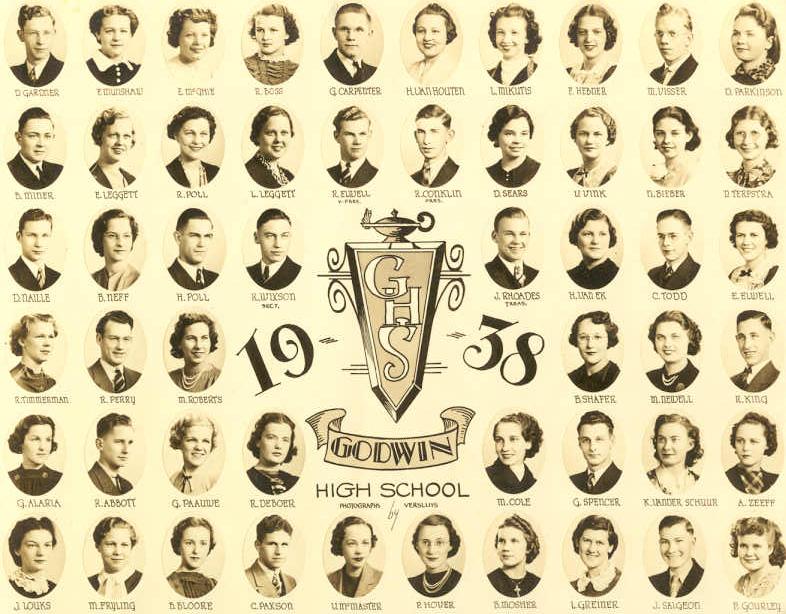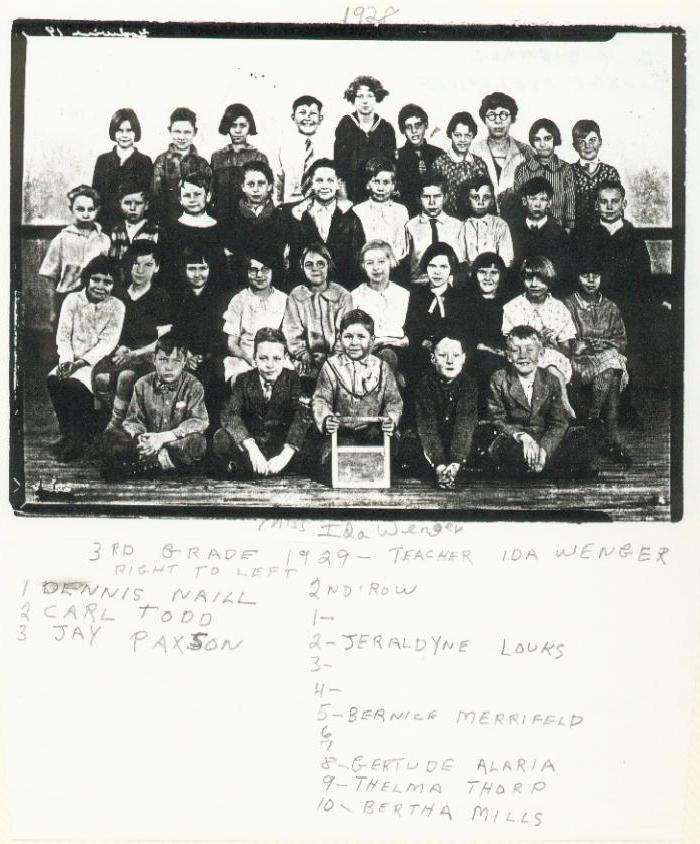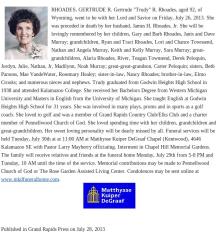
Class of 1938 -------------
Lee (Tanner) Collins, class of 1941, provided access to the annual.
Left click on the image for a much larger image.
( Photograph provided by Kim (Shepard) Brown, class of 1970. )
1938 class picture. Gertrude Alaria, shown on the left side, one up from the bottom row, is yet another Godwin graduate who would later return as an English teacher.

( Photograph provided by Lewis Lull, class of 1940, scanned by Craig Lull, class of 1970. )
Class of 1938 as third graders.
Left click on any image for a larger version.
Material provided by Mildred Annis, class of 1940.
Carroll Munshaw, class of 1929, joined Godwin as a teacher in the fall of 1937. There were several other Munshaw's that graduated from Godwin as well.
Mentioned on page 4, under "Gone But Not Forgotten," is Jack Charon, another Godwin graduate who would later return to become an athletic instructor.
Left click on any image for a larger version.
Material provided by Mildred Annis, class of 1940.
The "penny carnival," mentioned in the left column of page 3, dates back at least to when a penny was still worth bending over to pick up, and was still the entire price of something. The penny carnival was still going in the late 1950s. How much before 1937 the function existed, or how long after the 1950s, is not known yet.
Left click on any image for a larger version.
Material provided by Mildred Annis, class of 1940.
Frank Rackett presented a timber wolf to Godwin, as described on page 1. Like most other wildlife in Michigan, wolves were shot on sight, despite no credible evidence that one ever attacked a human. It's mildly miraculous that one still existed as late as 1937, but there are surely extinct now, with the exception of a pack on Royal Island. Wolverines were shot out by about 1900 in Michigan, the "Wovlerine State," and badgers are very rare in 2004.
By the early 1950s students had pulled one ear off the wolf, and as much hair as possible. Frank Rackett's collection was by then already so vandalized that access to the museum was restricted, to the point that it did no one much good. As a student in the 1950s and early 1960s, I never really saw the museum. In order to protect what was left of the collection it was largely off limits, and because the school never had the facilities to properly display the collection, which would have included put the stuffed animals inside glass enclosures, the collection mostly collected dust. The insect collections will decay if not properly cared for. It's said that many of the exhibits have, as of 2004, been thrown away. The school does not say much when asked about the collection, and one can only assume that it is largley but a memory now.
Left click on any image for a larger version.
Material provided by Mildred Annis, class of 1940.
Left click on any image for a larger version.
Material provided by Mildred Annis, class of 1940.
Left click on any image for a larger version.
Material provided by Mildred Annis, class of 1940.
Left click on any image for a larger version.
Material provided by Mildred Annis, class of 1940.
Left click on any image for a larger version.
Material provided by Mildred Annis, class of 1940.
Material provided by Mildred Annis, class of 1940.
Material provided by Mildred Annis, class of 1940.
Material provided by Mildred Annis, class of 1940.
Material provided by Mildred Annis, class of 1940.
Left click on any page for a larger version.
|
|
|
||
|
|
|
Material provided by Lillian Annis, class of 1941
Left click on the item below for a larger version.
Material provided by Lillian Annis, class of 1941
Continuing a trend that would not change much until the late 1950s, two women took top scholastic honors in 1938. Moreover, the top six scholastic achievers were women. For whatever the detailed reasons, the male students did not spend much of their time studying.
Left click on the item below for a larger version.
Material provided by Lillian Annis, class of 1941
Popular up to perhaps the early 1960s, mock elections were a way for class members to formalize the opinions of the gossip chains. People mostly agreed on who the prettiest woman in each class was, or the handsomest man, or the best this or that, and the mock election somewhat provide a formal vote on the issues. As the world grew more touchy about most social matters, things like mock elections could not longer be held without someone deciding they were offended.
Left click on the item below for a larger version.
Material provided by Lillian Annis, class of 1941
Legions of (mostly) women would spend the vast part of their working lives turning out endless memos, purchase orders, and other documents using rather primitive mechanical typewriters. Totally unforgiving of mistakes, in a today's PC world it is hard to remember now what using a mechanical typewriter was like. A premium was put on words per minute without mistakes. Fifty words per minute was good enough to get a job. One hundred words per minute was almost good enough to get an award. Even being able to do this depended on the typewriter being able to go that fast without keys jamming, and demanded a good touch on the part of the typist. The "QWERTY" key layout was actually designed to slow a typist down so that keys would not stick so often, and in no was is the optimum layout for fast typing. Every mistake meant using something like whiteout, or overtyping, which was frowned on. Duplicate copies might mean carbon paper, increasing the burden of every mistake. The typist had to be able to spell, and was in every sense the spell checker for her own work, as well as the material she was asked to type.
By the early 1960s machines like the IBM Selectric ball typewriter had eliminated the key jamming problem, and most incorporated a correction ribbon, which automatically applied a white substance to the mistake simply be back spacing and hitting the mistake key again. In about 1962 yet, the machines were very expensive, and each student only got a little time on one. But they were the harbinger of the office of the near future. Of course by that time the typing days of members of the class of 1938 were mostly well behind them, and then ended up slugging it out with the older machines.
All of this seems quaint in year 2006, While the "QWERTY" layout still prevails, always because too many people know how to use it ot give it up, every other aspect of "typing" is now vastly better than it was almost 70 years ago. Essentially every aspect of typing on a PC brings with it spelling checkers, and programs to lay out a page in a uniform way. Different fonts are a simple matter of selection. Various kinds of forms are just a matter of selection one from a package of forms. Backups and filing are almost automatic, and at most a user has to back up his/her PC now and then. And yes, both males and females type in year 2006. Typing, as a single duty, went away with the introduction of the PC, and the few secretaries left would sooner spit on anyone asking them to type something than to do it. In general it is more efficient all around for people to type things themselves. There is not longer even a concept of a first, second, third, etc., draft. and various kinds of software ensure that the typical user appears literate.
|
|
|
|
Left click on the images below for larger versions.

|

|